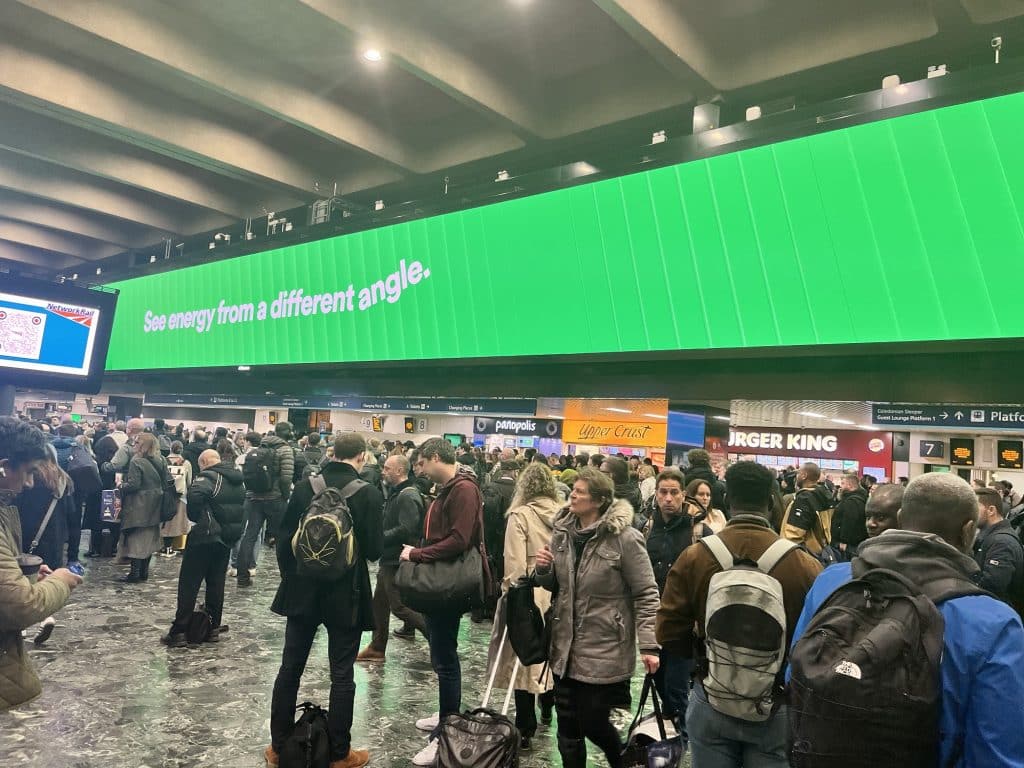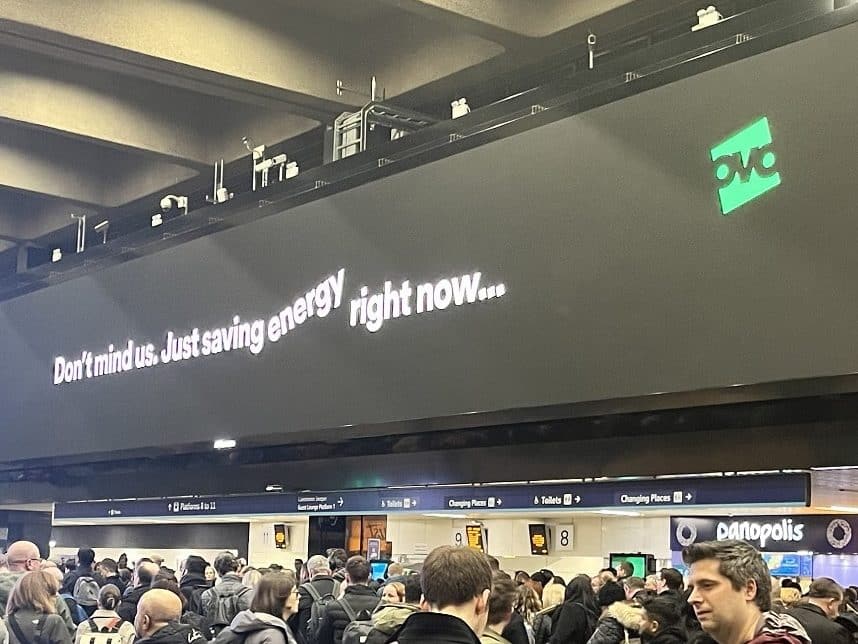In recent years, Euston Station – one of London’s biggest and busiest train stations – has changed a bit. It used to be the case that train and platform information was displayed on a giant bank of boards that stretched the length of the 60-metre concourse, listing the next 15 trains to depart, while a few other boards detailed which trains would follow and which were due to arrive. This long bank of boards was above the entrance to the platforms, so everyone would wait crammed into the concourse, looking up at the boards.
Now, after a £1.5m redesign, train information has been moved to two double-sided banks of monitors, each a fraction of the size of the old ones, positioned orthogonally in the middle of the concourse, taking up space where people would otherwise be standing. As they’re much smaller, you can’t read them unless you’re close, so half of the concourse can’t make out the information. Plus, because they’re orthogonally placed, those in the seating area on the upper floor can’t see them at all, they only see the end of the bank of monitors.
Meanwhile, in that 60-metre space above the entrance to the platforms, highly visible from any part of the concourse (even the parts where the train information is impossible to see), is a very long, very bright screen, beaming out adverts. Currently, it pours bright green light into the concourse; an advert for Ovo energy, proudly inviting us to see energy from a different angle.

Not only is the Ovo ad incredibly bright, it’s animated in a way that makes it difficult to ignore, occasionally turning black, with the message “Don’t mind us. Just saving energy right now…”

It’s hard not to appreciate the irony. Passengers have been shunted into a more inconvenient experience, so that an advert can be prioritised over access to train information. That advert, in this case, is an energy-guzzling electronic screen, bright enough to be uncomfortable to stand near, advertising an energy company that’s so proud of its green energy credentials that their brand colours are chosen to highlight them. And then, periodically, the advert cuts to a boast about how it is saving energy, by turning around 95% of their pixels black.
Digital Out-Of-Home (OOH) advertising really bothers me. My home, in Liverpool, is in a Green Party council-run area. Recently, a new digital advertising board was installed – three metres high, a metre wide, and situated in the middle of the pavement on the route to the nearest supermarket. It mostly features stills from LBC news and an advert for itself – inviting businesses to rent out that advertising space. It’s distractingly bright, animated to catch the eye (regardless of being beside a very busy road), and situated where people have to walk around it to get to local amenities. Nobody asked for it, nobody wanted it, and nobody needed it. And it runs 24 hours a day, pushing advertising messages uninvited into the brains of anyone who walks, or drives, by.
Energy consumption
There are a few ways to estimate how much energy electronic billboards consume. The average power consumption of a full-colour LED billboard is estimated to be around 230 Watts (or 0.23 kW) per square metre. Typical screen sizes in the UK are small (1.8m by 3.7 m); medium (3 m by 9.1 m); or large (4.3m by 14.6 m). Those are converted from feet, where the measurements are much rounder, but they represent 6.66 sqm, 27.3 sqm, and 62.8 sqm respectively. Assuming each consumes at the estimated average hourly rate, for 24 hours a day, their annual power consumptions are 13.4 MWh, 57.4 MWh, and 126.5 MWh respectively.
I’m not the first to try to quantify this consumption. The action group Ad Free Cities looked at an LED digital billboard that advertising company JCDecaux applied for permission to install in South Bristol in 2021. The billboard, which is manufactured by Daktronics, would be classified as around medium size, and its technical specifications claim a typical power usage of 4,752 Watts, or 42 MWh per year.
Elsewhere, in January 2022 a Guardian article looked at small-sized digital screens, like the one I have to walk around on the way to the supermarket (a criticism that has been levelled at many similar screens, with pavement space inconveniently reduced to accommodate the advertising messaging). The Guardian found that each of these screens consumed 11.5 MWh per year – with 86 such screens on the streets of Manchester consuming 989 MWh per year in total.
For context, in 2020 the Department for Business, Energy and Industrial Strategy lists the average electricity consumption per household as 3.9 MWh per year, while Ofgen’s estimate is a little lower, at 2.7 MWh. But even assuming the higher usage, each of those standing screens on the streets of Manchester uses as much electricity per year as three households. A single medium-sized billboard screen – the likes of which catch the eyes of drivers on roads across the country – uses as much electricity as eleven households. And an extra-large, 62 sqm screen consumes as much energy as 32 households.
According to Statista, there are 14,560 advertising screens in the UK. No data is available on their cumulative area, but even if assuming, on average, they each had the consumption of a small-sized billboard, their total consumption exceed that of 50,000 households.
Back to Euston station
What about that billboard in Euston? No full technical specifications are available, but an announcement of OVO’s advert, in partnership with Saatchi & Saatchi and Goodstuff, describes it as a 60 m billboard. Given that its height looks to be around 4 m, we can reasonably assume the 60 m description refers to its length, not its area. If the 4 m height estimate is indeed reasonable, its area would be 240 sqm, and its approximate annual energy usage would be 484 MWh, or the equivalent of 124 homes.
However, as the ad claims, it periodically powers down to save money, by switching to a mostly black screen? If the screen is a modern LED screen, it would be possible to reduce energy consumption by switching pixels to a darker hue. If a black pixel used around a third as much energy as bright one, and if roughly 95% of the pixels in the “energy saving” video are black, and if we assume that the screen spends half of its time displaying the energy-saving ad (which, from observing it, it definitely does not) – given all those rough assumptions, this energy saving advert would still use the equivalent energy of 103 homes. While also being the centrepiece of a high-profile, back-slapping industry boast about sustainable energy usage and responsible advertising.
Ovo, Saatchi, and JCDecaux might say that their adverts are environmentally responsible, because they use renewable energy. And, in fact, they ran an ad campaign back in September where ads would show when the National Grid was running on renewables – which, of course, was the subject of a self-congratulatory news article in the industry press patting themselves on the back for this innovation. But is this really socially responsible? Or does it merely claim credit for only wasting energy when that energy is cheap to generate… wasting energy all the same.
The important aspect here isn’t just the cost in terms of energy consumption, but the opportunity cost; in other words, even when the energy is renewably sourced, it could still be used to power something more productive and useful than an advertising screen the size of a wall, particularly during a much-documented energy crisis. The issue is of cost-benefit, and when it comes to these ads, the only benefit is to the advertiser.
Economic benefits and costs
It is undeniable that Euston will be paid a large amount of money for use of its advertising space over the course of the year, and those 86 pavement screens were projected to net Manchester around £2.4m a year. But assessment of the impact of this revenue has to take into account that those advertising income streams would exist, to a comparable degree, whether the ads were bright digital videos or old-school paper-and-paste ads, where the energy outlay and environmental impact is lower. What’s more, one of the chief benefits of digital advertising spaces is that they can rotate and change, hosting multiple ads in the same space – multiplying the revenue for the companies who run the screens, without necessarily passing along that increased revenue to the public spaces in which they appear.
Where does the generated revenue go? In the case of Euston, it doesn’t seem to appreciably lower ticket prices, given that train costs have risen by 4.9% this year. In the case of Manchester and Liverpool, it isn’t increasing the spending available for public infrastructure, or lowering the burden on residents – a particularly important point, given that 82% of outdoor advertising is in the poorest half of England and Wales, with six times more advertising in the most deprived areas compared to the least deprived.
I write all of this from the perspective of someone who has worked for nearly 20 years in the digital marketing industry (though never, it’s worth pointing out, in advertising), and most of that time was spent working with clients in the energy industry specifically. But at the height of an energy crisis, we are burning electricity for the sole purpose of having a company’s preferred message delivered to the public in places where they did not consent to see it, have no say in it, and cannot avoid it.
Public advertising is making our lives, and our engagement with the places that make up our day-to-day lives, shittier – and in the case of electronic adverts in particular, at the expense of the planet. While you’re told to turn your TV off standby over night, turn your heating down by a degree, and take personal responsibility for your carbon footprint, screens the size of walls are wasting more energy than your entire street, and the people behind them are patting themselves on the back for their responsible energy use, because they’ve never actually paused to consider what’s actually involved.
Electronic advertising is a climate crime, and it’s one we shouldn’t just stand by and allow to happen.


